Business Innovation Through Open Data: Opportunities & Challenges
VerifiedAdded on 2023/06/13
|16
|4020
|95
Report
AI Summary
This report explores the significance of open data in contemporary business, examining its increasing popularity and utilization by organizations to gain a competitive edge. It evaluates how companies leverage open data for business innovation, providing examples of corporations that have successfully fostered innovation through its use. The report also offers recommendations for organizations seeking to harness open data to promote business innovation, drawing on secondary research from journal articles to analyze the role of open data in identifying market gaps and developing new products and services. It further discusses the potential economic value and risks associated with open data, emphasizing its role in driving innovation across various sectors while acknowledging concerns related to social inequality, cyber-attacks, and national security.
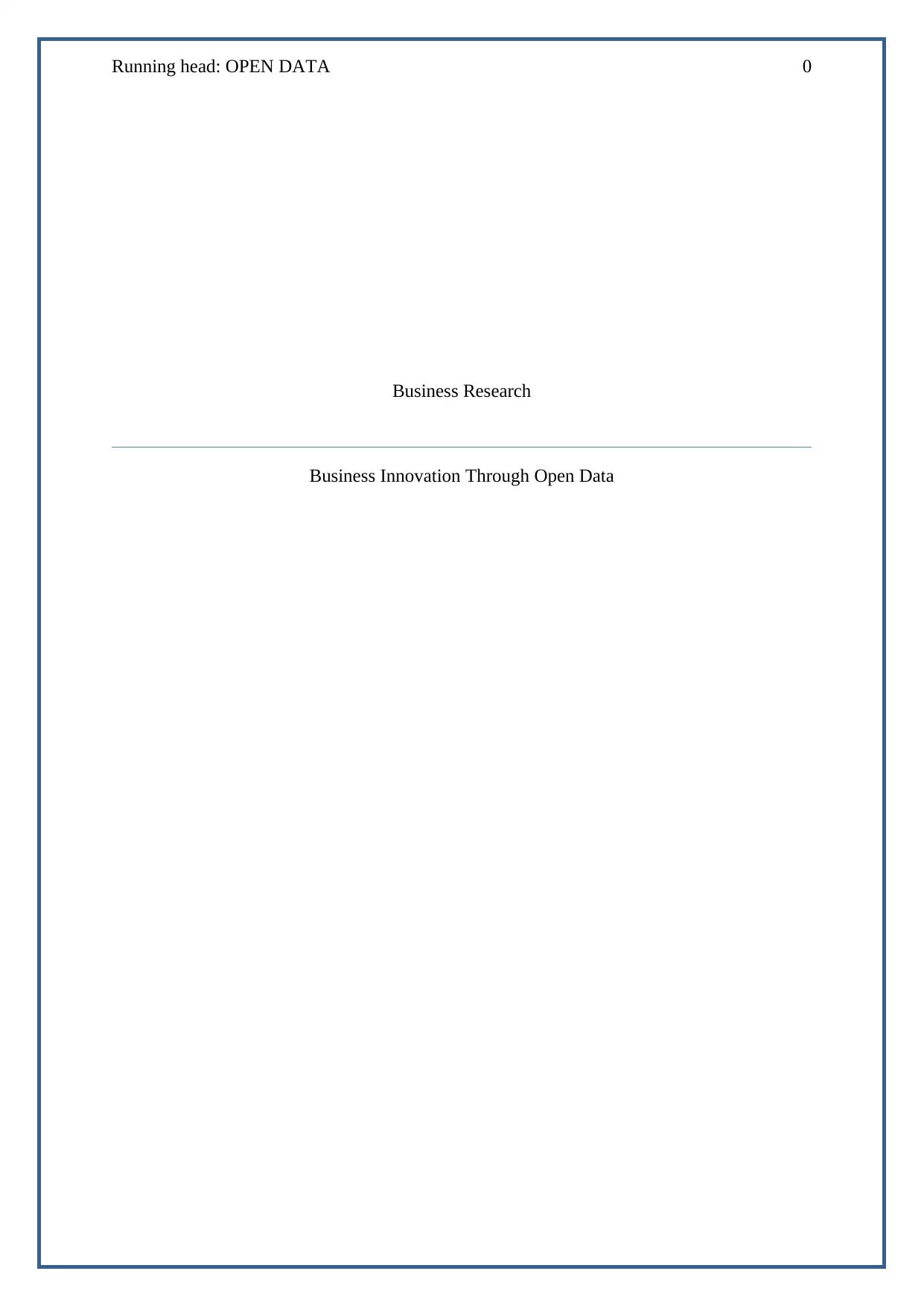
Running head: OPEN DATA 0
Business Research
Business Innovation Through Open Data
Business Research
Business Innovation Through Open Data
Paraphrase This Document
Need a fresh take? Get an instant paraphrase of this document with our AI Paraphraser
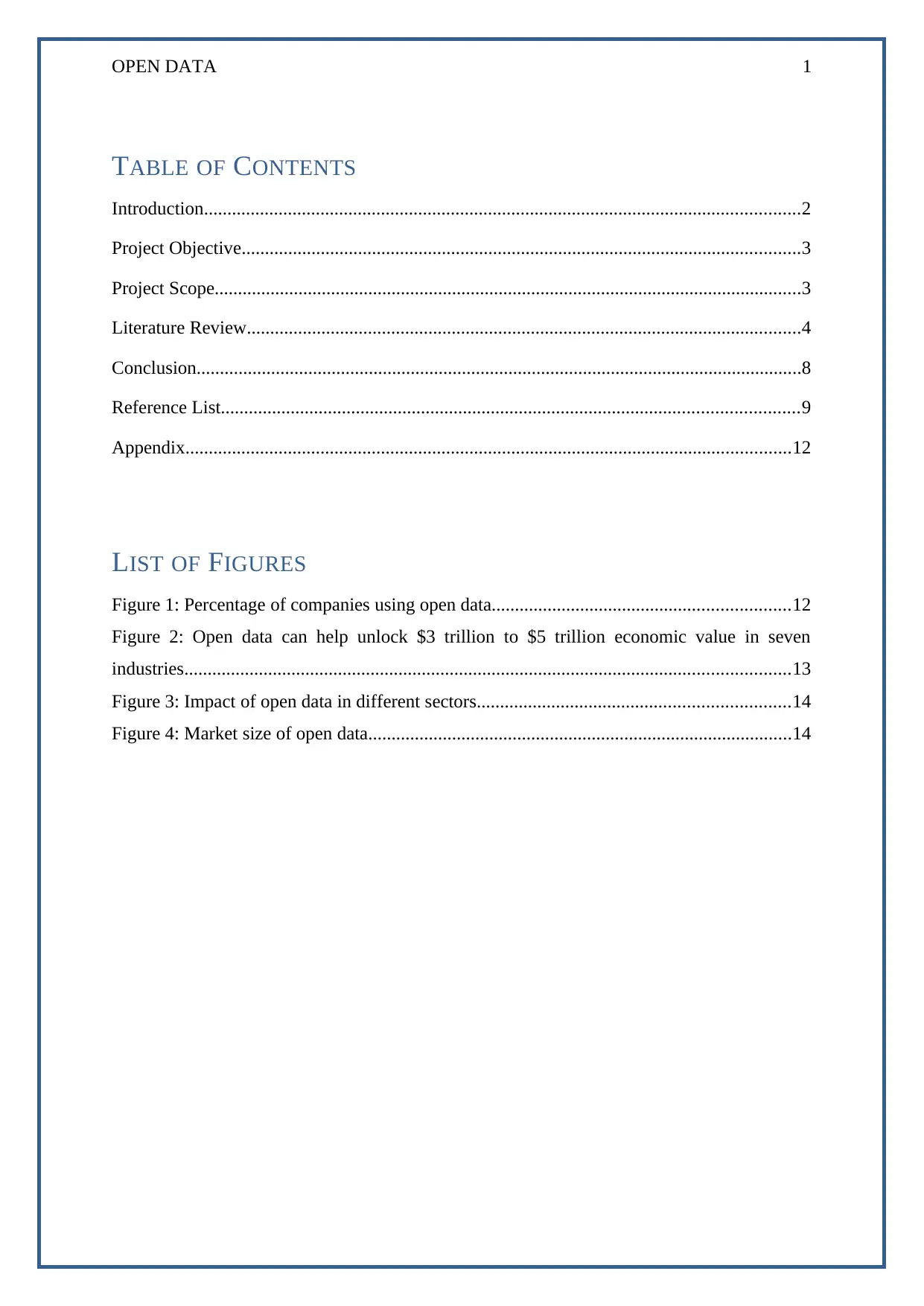
OPEN DATA 1
TABLE OF CONTENTS
Introduction................................................................................................................................2
Project Objective........................................................................................................................3
Project Scope..............................................................................................................................3
Literature Review.......................................................................................................................4
Conclusion..................................................................................................................................8
Reference List............................................................................................................................9
Appendix..................................................................................................................................12
LIST OF FIGURES
Figure 1: Percentage of companies using open data................................................................12
Figure 2: Open data can help unlock $3 trillion to $5 trillion economic value in seven
industries..................................................................................................................................13
Figure 3: Impact of open data in different sectors...................................................................14
Figure 4: Market size of open data...........................................................................................14
TABLE OF CONTENTS
Introduction................................................................................................................................2
Project Objective........................................................................................................................3
Project Scope..............................................................................................................................3
Literature Review.......................................................................................................................4
Conclusion..................................................................................................................................8
Reference List............................................................................................................................9
Appendix..................................................................................................................................12
LIST OF FIGURES
Figure 1: Percentage of companies using open data................................................................12
Figure 2: Open data can help unlock $3 trillion to $5 trillion economic value in seven
industries..................................................................................................................................13
Figure 3: Impact of open data in different sectors...................................................................14
Figure 4: Market size of open data...........................................................................................14
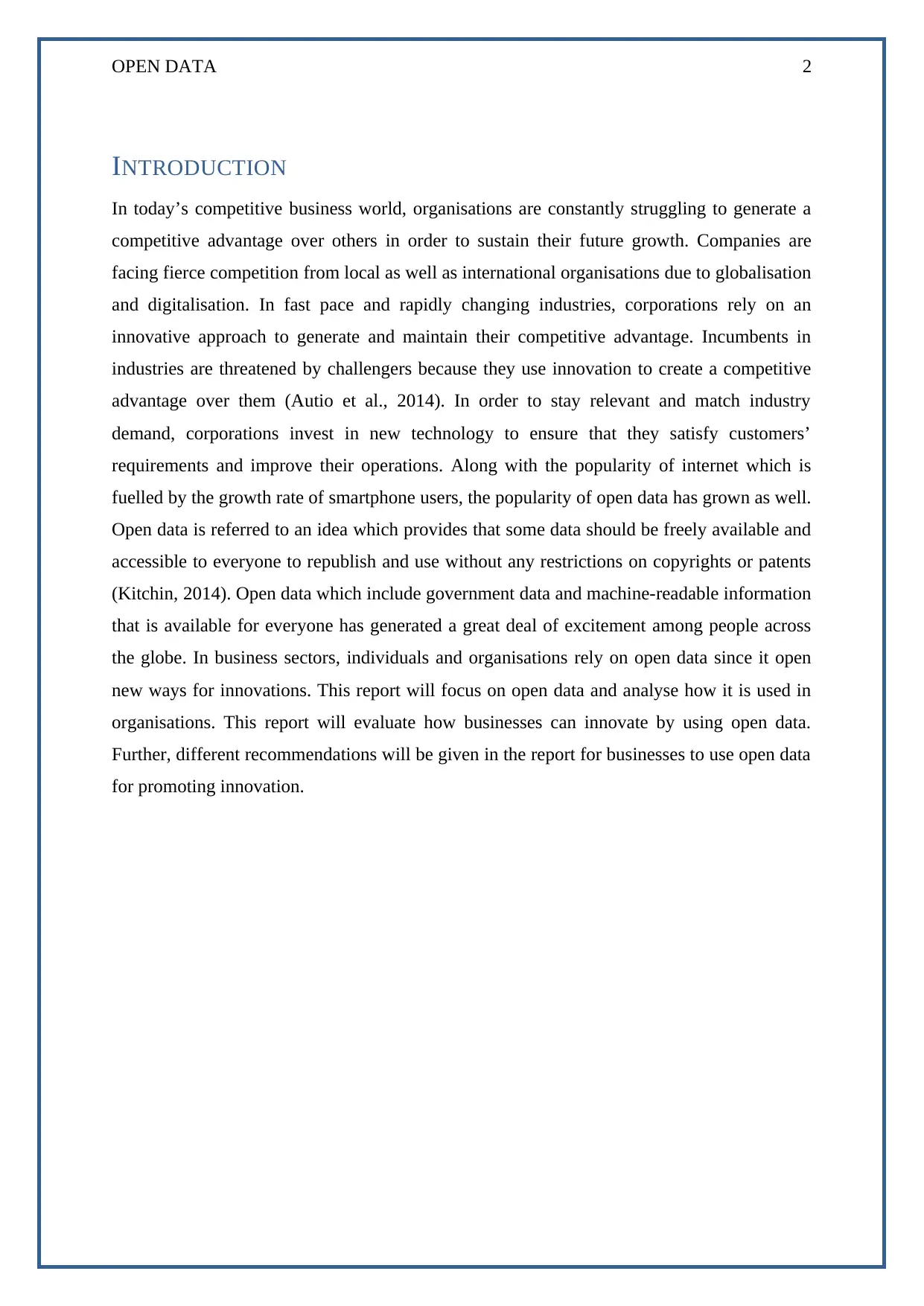
OPEN DATA 2
INTRODUCTION
In today’s competitive business world, organisations are constantly struggling to generate a
competitive advantage over others in order to sustain their future growth. Companies are
facing fierce competition from local as well as international organisations due to globalisation
and digitalisation. In fast pace and rapidly changing industries, corporations rely on an
innovative approach to generate and maintain their competitive advantage. Incumbents in
industries are threatened by challengers because they use innovation to create a competitive
advantage over them (Autio et al., 2014). In order to stay relevant and match industry
demand, corporations invest in new technology to ensure that they satisfy customers’
requirements and improve their operations. Along with the popularity of internet which is
fuelled by the growth rate of smartphone users, the popularity of open data has grown as well.
Open data is referred to an idea which provides that some data should be freely available and
accessible to everyone to republish and use without any restrictions on copyrights or patents
(Kitchin, 2014). Open data which include government data and machine-readable information
that is available for everyone has generated a great deal of excitement among people across
the globe. In business sectors, individuals and organisations rely on open data since it open
new ways for innovations. This report will focus on open data and analyse how it is used in
organisations. This report will evaluate how businesses can innovate by using open data.
Further, different recommendations will be given in the report for businesses to use open data
for promoting innovation.
INTRODUCTION
In today’s competitive business world, organisations are constantly struggling to generate a
competitive advantage over others in order to sustain their future growth. Companies are
facing fierce competition from local as well as international organisations due to globalisation
and digitalisation. In fast pace and rapidly changing industries, corporations rely on an
innovative approach to generate and maintain their competitive advantage. Incumbents in
industries are threatened by challengers because they use innovation to create a competitive
advantage over them (Autio et al., 2014). In order to stay relevant and match industry
demand, corporations invest in new technology to ensure that they satisfy customers’
requirements and improve their operations. Along with the popularity of internet which is
fuelled by the growth rate of smartphone users, the popularity of open data has grown as well.
Open data is referred to an idea which provides that some data should be freely available and
accessible to everyone to republish and use without any restrictions on copyrights or patents
(Kitchin, 2014). Open data which include government data and machine-readable information
that is available for everyone has generated a great deal of excitement among people across
the globe. In business sectors, individuals and organisations rely on open data since it open
new ways for innovations. This report will focus on open data and analyse how it is used in
organisations. This report will evaluate how businesses can innovate by using open data.
Further, different recommendations will be given in the report for businesses to use open data
for promoting innovation.
⊘ This is a preview!⊘
Do you want full access?
Subscribe today to unlock all pages.

Trusted by 1+ million students worldwide
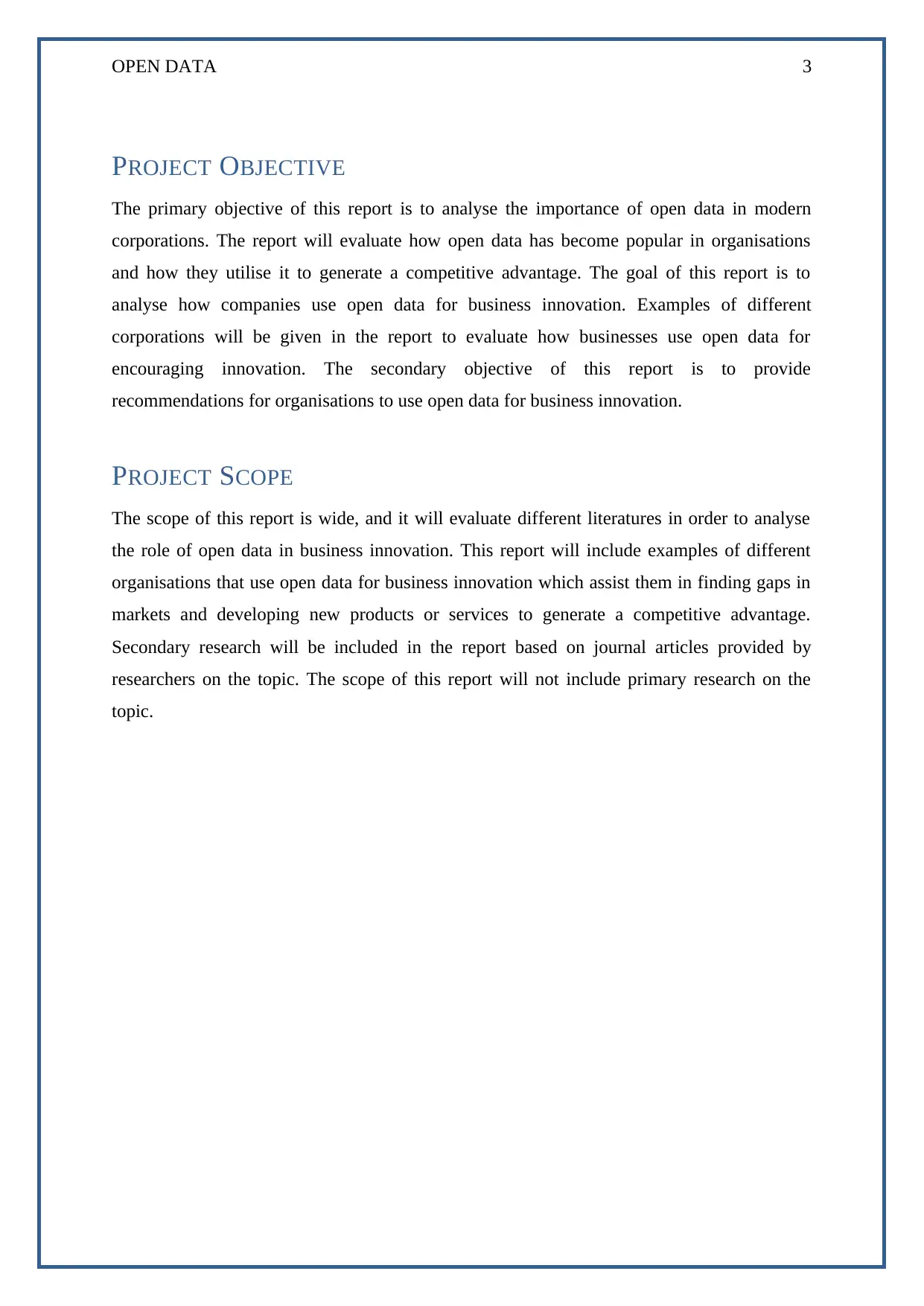
OPEN DATA 3
PROJECT OBJECTIVE
The primary objective of this report is to analyse the importance of open data in modern
corporations. The report will evaluate how open data has become popular in organisations
and how they utilise it to generate a competitive advantage. The goal of this report is to
analyse how companies use open data for business innovation. Examples of different
corporations will be given in the report to evaluate how businesses use open data for
encouraging innovation. The secondary objective of this report is to provide
recommendations for organisations to use open data for business innovation.
PROJECT SCOPE
The scope of this report is wide, and it will evaluate different literatures in order to analyse
the role of open data in business innovation. This report will include examples of different
organisations that use open data for business innovation which assist them in finding gaps in
markets and developing new products or services to generate a competitive advantage.
Secondary research will be included in the report based on journal articles provided by
researchers on the topic. The scope of this report will not include primary research on the
topic.
PROJECT OBJECTIVE
The primary objective of this report is to analyse the importance of open data in modern
corporations. The report will evaluate how open data has become popular in organisations
and how they utilise it to generate a competitive advantage. The goal of this report is to
analyse how companies use open data for business innovation. Examples of different
corporations will be given in the report to evaluate how businesses use open data for
encouraging innovation. The secondary objective of this report is to provide
recommendations for organisations to use open data for business innovation.
PROJECT SCOPE
The scope of this report is wide, and it will evaluate different literatures in order to analyse
the role of open data in business innovation. This report will include examples of different
organisations that use open data for business innovation which assist them in finding gaps in
markets and developing new products or services to generate a competitive advantage.
Secondary research will be included in the report based on journal articles provided by
researchers on the topic. The scope of this report will not include primary research on the
topic.
Paraphrase This Document
Need a fresh take? Get an instant paraphrase of this document with our AI Paraphraser
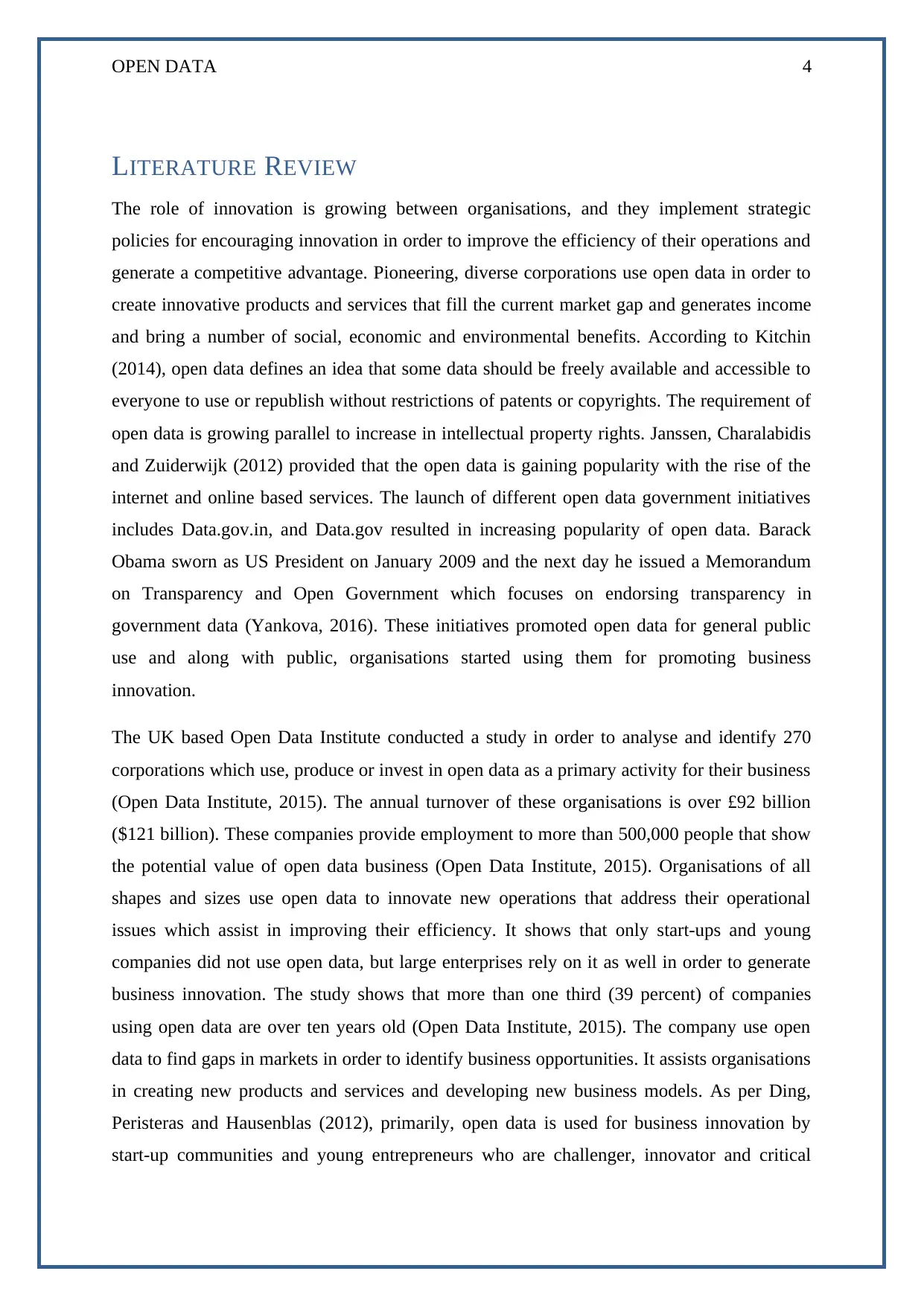
OPEN DATA 4
LITERATURE REVIEW
The role of innovation is growing between organisations, and they implement strategic
policies for encouraging innovation in order to improve the efficiency of their operations and
generate a competitive advantage. Pioneering, diverse corporations use open data in order to
create innovative products and services that fill the current market gap and generates income
and bring a number of social, economic and environmental benefits. According to Kitchin
(2014), open data defines an idea that some data should be freely available and accessible to
everyone to use or republish without restrictions of patents or copyrights. The requirement of
open data is growing parallel to increase in intellectual property rights. Janssen, Charalabidis
and Zuiderwijk (2012) provided that the open data is gaining popularity with the rise of the
internet and online based services. The launch of different open data government initiatives
includes Data.gov.in, and Data.gov resulted in increasing popularity of open data. Barack
Obama sworn as US President on January 2009 and the next day he issued a Memorandum
on Transparency and Open Government which focuses on endorsing transparency in
government data (Yankova, 2016). These initiatives promoted open data for general public
use and along with public, organisations started using them for promoting business
innovation.
The UK based Open Data Institute conducted a study in order to analyse and identify 270
corporations which use, produce or invest in open data as a primary activity for their business
(Open Data Institute, 2015). The annual turnover of these organisations is over £92 billion
($121 billion). These companies provide employment to more than 500,000 people that show
the potential value of open data business (Open Data Institute, 2015). Organisations of all
shapes and sizes use open data to innovate new operations that address their operational
issues which assist in improving their efficiency. It shows that only start-ups and young
companies did not use open data, but large enterprises rely on it as well in order to generate
business innovation. The study shows that more than one third (39 percent) of companies
using open data are over ten years old (Open Data Institute, 2015). The company use open
data to find gaps in markets in order to identify business opportunities. It assists organisations
in creating new products and services and developing new business models. As per Ding,
Peristeras and Hausenblas (2012), primarily, open data is used for business innovation by
start-up communities and young entrepreneurs who are challenger, innovator and critical
LITERATURE REVIEW
The role of innovation is growing between organisations, and they implement strategic
policies for encouraging innovation in order to improve the efficiency of their operations and
generate a competitive advantage. Pioneering, diverse corporations use open data in order to
create innovative products and services that fill the current market gap and generates income
and bring a number of social, economic and environmental benefits. According to Kitchin
(2014), open data defines an idea that some data should be freely available and accessible to
everyone to use or republish without restrictions of patents or copyrights. The requirement of
open data is growing parallel to increase in intellectual property rights. Janssen, Charalabidis
and Zuiderwijk (2012) provided that the open data is gaining popularity with the rise of the
internet and online based services. The launch of different open data government initiatives
includes Data.gov.in, and Data.gov resulted in increasing popularity of open data. Barack
Obama sworn as US President on January 2009 and the next day he issued a Memorandum
on Transparency and Open Government which focuses on endorsing transparency in
government data (Yankova, 2016). These initiatives promoted open data for general public
use and along with public, organisations started using them for promoting business
innovation.
The UK based Open Data Institute conducted a study in order to analyse and identify 270
corporations which use, produce or invest in open data as a primary activity for their business
(Open Data Institute, 2015). The annual turnover of these organisations is over £92 billion
($121 billion). These companies provide employment to more than 500,000 people that show
the potential value of open data business (Open Data Institute, 2015). Organisations of all
shapes and sizes use open data to innovate new operations that address their operational
issues which assist in improving their efficiency. It shows that only start-ups and young
companies did not use open data, but large enterprises rely on it as well in order to generate
business innovation. The study shows that more than one third (39 percent) of companies
using open data are over ten years old (Open Data Institute, 2015). The company use open
data to find gaps in markets in order to identify business opportunities. It assists organisations
in creating new products and services and developing new business models. As per Ding,
Peristeras and Hausenblas (2012), primarily, open data is used for business innovation by
start-up communities and young entrepreneurs who are challenger, innovator and critical
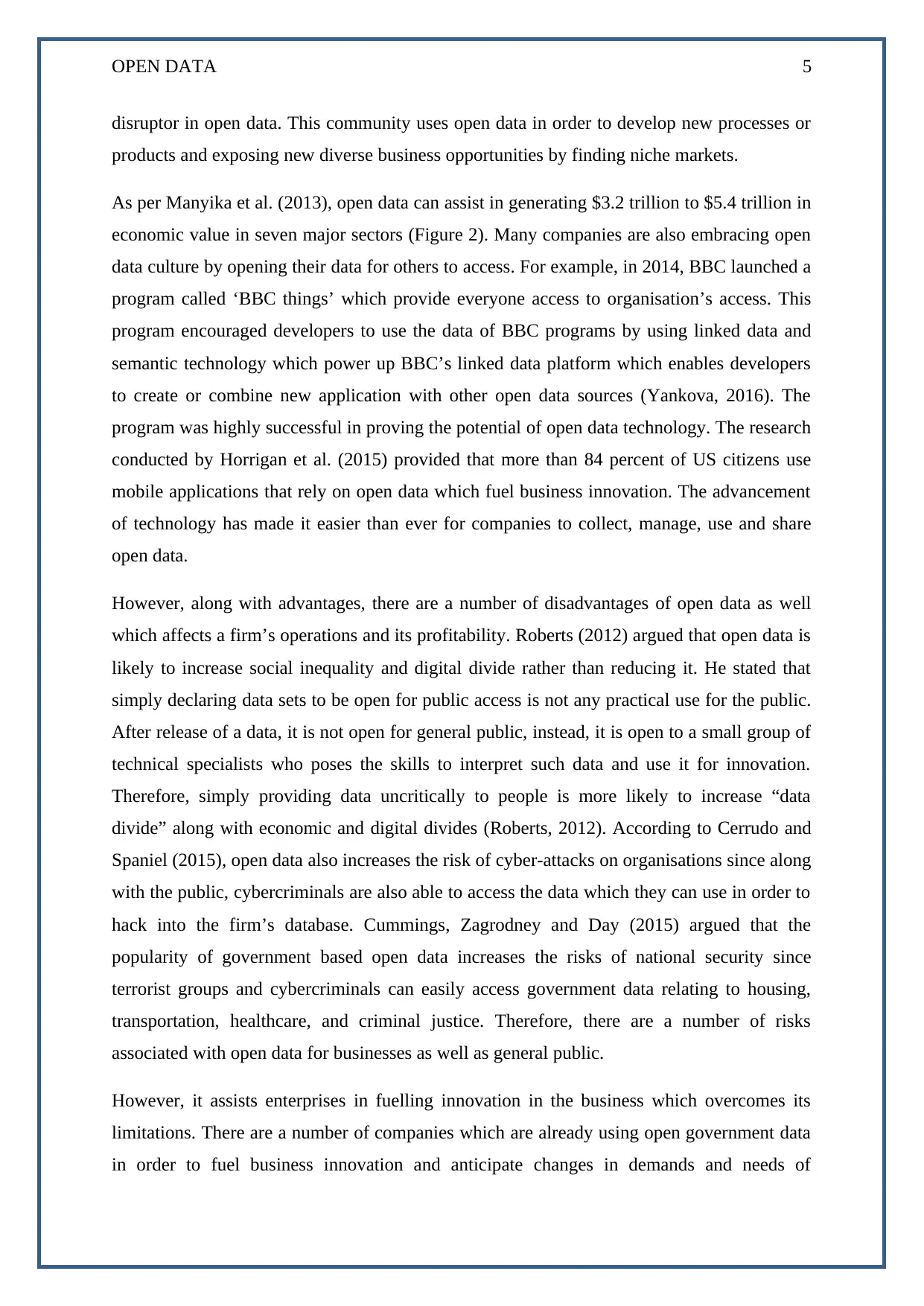
OPEN DATA 5
disruptor in open data. This community uses open data in order to develop new processes or
products and exposing new diverse business opportunities by finding niche markets.
As per Manyika et al. (2013), open data can assist in generating $3.2 trillion to $5.4 trillion in
economic value in seven major sectors (Figure 2). Many companies are also embracing open
data culture by opening their data for others to access. For example, in 2014, BBC launched a
program called ‘BBC things’ which provide everyone access to organisation’s access. This
program encouraged developers to use the data of BBC programs by using linked data and
semantic technology which power up BBC’s linked data platform which enables developers
to create or combine new application with other open data sources (Yankova, 2016). The
program was highly successful in proving the potential of open data technology. The research
conducted by Horrigan et al. (2015) provided that more than 84 percent of US citizens use
mobile applications that rely on open data which fuel business innovation. The advancement
of technology has made it easier than ever for companies to collect, manage, use and share
open data.
However, along with advantages, there are a number of disadvantages of open data as well
which affects a firm’s operations and its profitability. Roberts (2012) argued that open data is
likely to increase social inequality and digital divide rather than reducing it. He stated that
simply declaring data sets to be open for public access is not any practical use for the public.
After release of a data, it is not open for general public, instead, it is open to a small group of
technical specialists who poses the skills to interpret such data and use it for innovation.
Therefore, simply providing data uncritically to people is more likely to increase “data
divide” along with economic and digital divides (Roberts, 2012). According to Cerrudo and
Spaniel (2015), open data also increases the risk of cyber-attacks on organisations since along
with the public, cybercriminals are also able to access the data which they can use in order to
hack into the firm’s database. Cummings, Zagrodney and Day (2015) argued that the
popularity of government based open data increases the risks of national security since
terrorist groups and cybercriminals can easily access government data relating to housing,
transportation, healthcare, and criminal justice. Therefore, there are a number of risks
associated with open data for businesses as well as general public.
However, it assists enterprises in fuelling innovation in the business which overcomes its
limitations. There are a number of companies which are already using open government data
in order to fuel business innovation and anticipate changes in demands and needs of
disruptor in open data. This community uses open data in order to develop new processes or
products and exposing new diverse business opportunities by finding niche markets.
As per Manyika et al. (2013), open data can assist in generating $3.2 trillion to $5.4 trillion in
economic value in seven major sectors (Figure 2). Many companies are also embracing open
data culture by opening their data for others to access. For example, in 2014, BBC launched a
program called ‘BBC things’ which provide everyone access to organisation’s access. This
program encouraged developers to use the data of BBC programs by using linked data and
semantic technology which power up BBC’s linked data platform which enables developers
to create or combine new application with other open data sources (Yankova, 2016). The
program was highly successful in proving the potential of open data technology. The research
conducted by Horrigan et al. (2015) provided that more than 84 percent of US citizens use
mobile applications that rely on open data which fuel business innovation. The advancement
of technology has made it easier than ever for companies to collect, manage, use and share
open data.
However, along with advantages, there are a number of disadvantages of open data as well
which affects a firm’s operations and its profitability. Roberts (2012) argued that open data is
likely to increase social inequality and digital divide rather than reducing it. He stated that
simply declaring data sets to be open for public access is not any practical use for the public.
After release of a data, it is not open for general public, instead, it is open to a small group of
technical specialists who poses the skills to interpret such data and use it for innovation.
Therefore, simply providing data uncritically to people is more likely to increase “data
divide” along with economic and digital divides (Roberts, 2012). According to Cerrudo and
Spaniel (2015), open data also increases the risk of cyber-attacks on organisations since along
with the public, cybercriminals are also able to access the data which they can use in order to
hack into the firm’s database. Cummings, Zagrodney and Day (2015) argued that the
popularity of government based open data increases the risks of national security since
terrorist groups and cybercriminals can easily access government data relating to housing,
transportation, healthcare, and criminal justice. Therefore, there are a number of risks
associated with open data for businesses as well as general public.
However, it assists enterprises in fuelling innovation in the business which overcomes its
limitations. There are a number of companies which are already using open government data
in order to fuel business innovation and anticipate changes in demands and needs of
⊘ This is a preview!⊘
Do you want full access?
Subscribe today to unlock all pages.

Trusted by 1+ million students worldwide
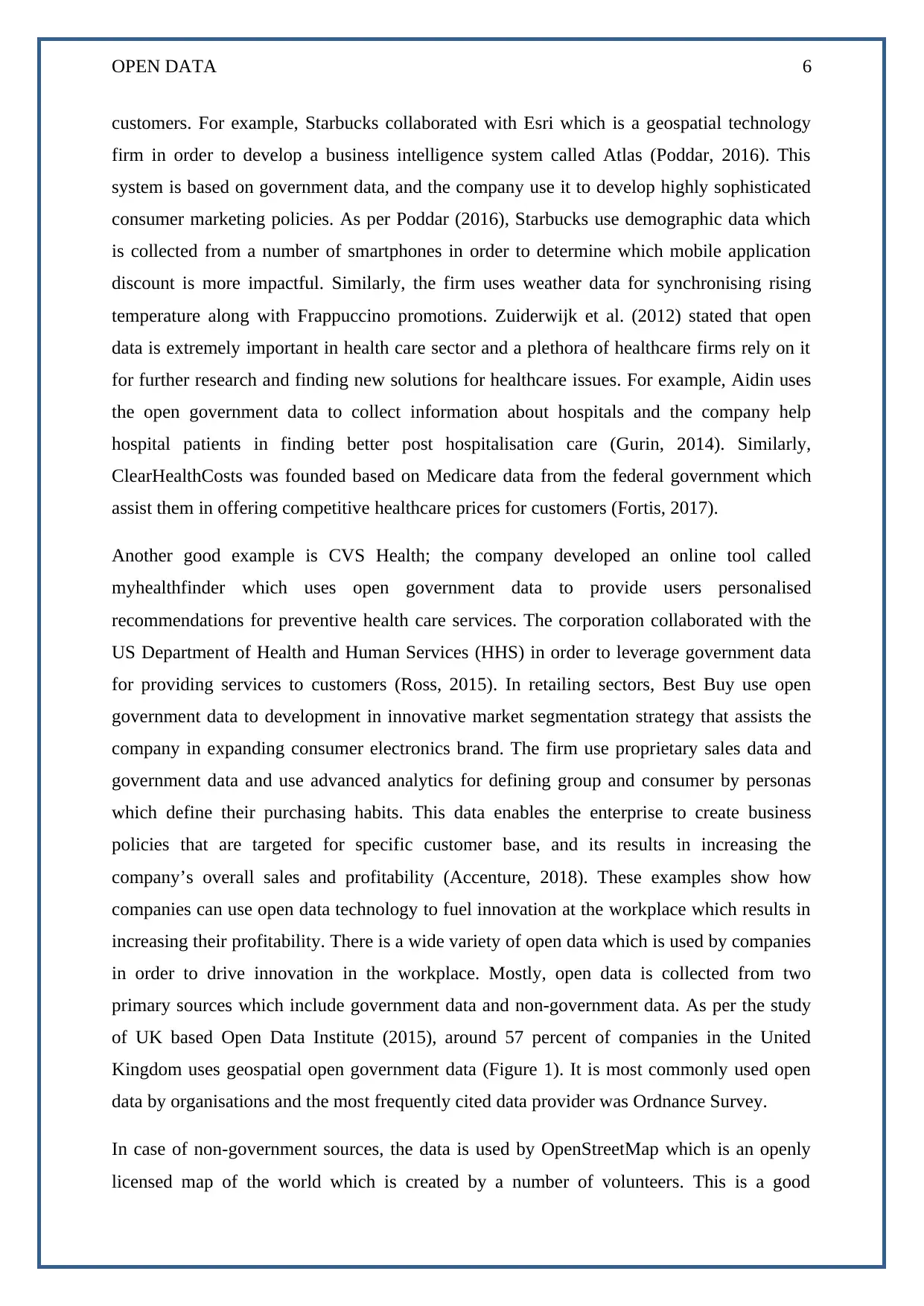
OPEN DATA 6
customers. For example, Starbucks collaborated with Esri which is a geospatial technology
firm in order to develop a business intelligence system called Atlas (Poddar, 2016). This
system is based on government data, and the company use it to develop highly sophisticated
consumer marketing policies. As per Poddar (2016), Starbucks use demographic data which
is collected from a number of smartphones in order to determine which mobile application
discount is more impactful. Similarly, the firm uses weather data for synchronising rising
temperature along with Frappuccino promotions. Zuiderwijk et al. (2012) stated that open
data is extremely important in health care sector and a plethora of healthcare firms rely on it
for further research and finding new solutions for healthcare issues. For example, Aidin uses
the open government data to collect information about hospitals and the company help
hospital patients in finding better post hospitalisation care (Gurin, 2014). Similarly,
ClearHealthCosts was founded based on Medicare data from the federal government which
assist them in offering competitive healthcare prices for customers (Fortis, 2017).
Another good example is CVS Health; the company developed an online tool called
myhealthfinder which uses open government data to provide users personalised
recommendations for preventive health care services. The corporation collaborated with the
US Department of Health and Human Services (HHS) in order to leverage government data
for providing services to customers (Ross, 2015). In retailing sectors, Best Buy use open
government data to development in innovative market segmentation strategy that assists the
company in expanding consumer electronics brand. The firm use proprietary sales data and
government data and use advanced analytics for defining group and consumer by personas
which define their purchasing habits. This data enables the enterprise to create business
policies that are targeted for specific customer base, and its results in increasing the
company’s overall sales and profitability (Accenture, 2018). These examples show how
companies can use open data technology to fuel innovation at the workplace which results in
increasing their profitability. There is a wide variety of open data which is used by companies
in order to drive innovation in the workplace. Mostly, open data is collected from two
primary sources which include government data and non-government data. As per the study
of UK based Open Data Institute (2015), around 57 percent of companies in the United
Kingdom uses geospatial open government data (Figure 1). It is most commonly used open
data by organisations and the most frequently cited data provider was Ordnance Survey.
In case of non-government sources, the data is used by OpenStreetMap which is an openly
licensed map of the world which is created by a number of volunteers. This is a good
customers. For example, Starbucks collaborated with Esri which is a geospatial technology
firm in order to develop a business intelligence system called Atlas (Poddar, 2016). This
system is based on government data, and the company use it to develop highly sophisticated
consumer marketing policies. As per Poddar (2016), Starbucks use demographic data which
is collected from a number of smartphones in order to determine which mobile application
discount is more impactful. Similarly, the firm uses weather data for synchronising rising
temperature along with Frappuccino promotions. Zuiderwijk et al. (2012) stated that open
data is extremely important in health care sector and a plethora of healthcare firms rely on it
for further research and finding new solutions for healthcare issues. For example, Aidin uses
the open government data to collect information about hospitals and the company help
hospital patients in finding better post hospitalisation care (Gurin, 2014). Similarly,
ClearHealthCosts was founded based on Medicare data from the federal government which
assist them in offering competitive healthcare prices for customers (Fortis, 2017).
Another good example is CVS Health; the company developed an online tool called
myhealthfinder which uses open government data to provide users personalised
recommendations for preventive health care services. The corporation collaborated with the
US Department of Health and Human Services (HHS) in order to leverage government data
for providing services to customers (Ross, 2015). In retailing sectors, Best Buy use open
government data to development in innovative market segmentation strategy that assists the
company in expanding consumer electronics brand. The firm use proprietary sales data and
government data and use advanced analytics for defining group and consumer by personas
which define their purchasing habits. This data enables the enterprise to create business
policies that are targeted for specific customer base, and its results in increasing the
company’s overall sales and profitability (Accenture, 2018). These examples show how
companies can use open data technology to fuel innovation at the workplace which results in
increasing their profitability. There is a wide variety of open data which is used by companies
in order to drive innovation in the workplace. Mostly, open data is collected from two
primary sources which include government data and non-government data. As per the study
of UK based Open Data Institute (2015), around 57 percent of companies in the United
Kingdom uses geospatial open government data (Figure 1). It is most commonly used open
data by organisations and the most frequently cited data provider was Ordnance Survey.
In case of non-government sources, the data is used by OpenStreetMap which is an openly
licensed map of the world which is created by a number of volunteers. This is a good
Paraphrase This Document
Need a fresh take? Get an instant paraphrase of this document with our AI Paraphraser
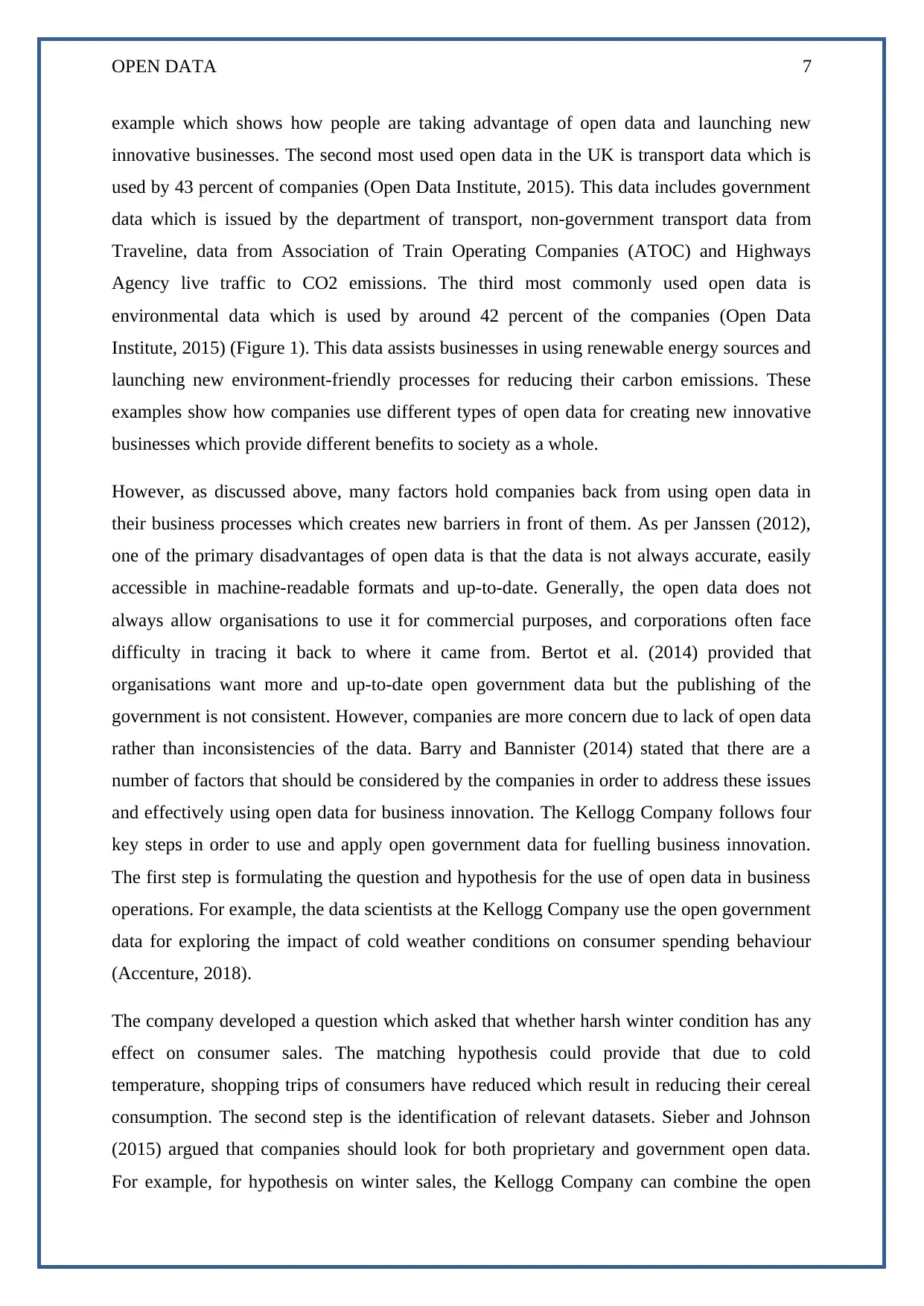
OPEN DATA 7
example which shows how people are taking advantage of open data and launching new
innovative businesses. The second most used open data in the UK is transport data which is
used by 43 percent of companies (Open Data Institute, 2015). This data includes government
data which is issued by the department of transport, non-government transport data from
Traveline, data from Association of Train Operating Companies (ATOC) and Highways
Agency live traffic to CO2 emissions. The third most commonly used open data is
environmental data which is used by around 42 percent of the companies (Open Data
Institute, 2015) (Figure 1). This data assists businesses in using renewable energy sources and
launching new environment-friendly processes for reducing their carbon emissions. These
examples show how companies use different types of open data for creating new innovative
businesses which provide different benefits to society as a whole.
However, as discussed above, many factors hold companies back from using open data in
their business processes which creates new barriers in front of them. As per Janssen (2012),
one of the primary disadvantages of open data is that the data is not always accurate, easily
accessible in machine-readable formats and up-to-date. Generally, the open data does not
always allow organisations to use it for commercial purposes, and corporations often face
difficulty in tracing it back to where it came from. Bertot et al. (2014) provided that
organisations want more and up-to-date open government data but the publishing of the
government is not consistent. However, companies are more concern due to lack of open data
rather than inconsistencies of the data. Barry and Bannister (2014) stated that there are a
number of factors that should be considered by the companies in order to address these issues
and effectively using open data for business innovation. The Kellogg Company follows four
key steps in order to use and apply open government data for fuelling business innovation.
The first step is formulating the question and hypothesis for the use of open data in business
operations. For example, the data scientists at the Kellogg Company use the open government
data for exploring the impact of cold weather conditions on consumer spending behaviour
(Accenture, 2018).
The company developed a question which asked that whether harsh winter condition has any
effect on consumer sales. The matching hypothesis could provide that due to cold
temperature, shopping trips of consumers have reduced which result in reducing their cereal
consumption. The second step is the identification of relevant datasets. Sieber and Johnson
(2015) argued that companies should look for both proprietary and government open data.
For example, for hypothesis on winter sales, the Kellogg Company can combine the open
example which shows how people are taking advantage of open data and launching new
innovative businesses. The second most used open data in the UK is transport data which is
used by 43 percent of companies (Open Data Institute, 2015). This data includes government
data which is issued by the department of transport, non-government transport data from
Traveline, data from Association of Train Operating Companies (ATOC) and Highways
Agency live traffic to CO2 emissions. The third most commonly used open data is
environmental data which is used by around 42 percent of the companies (Open Data
Institute, 2015) (Figure 1). This data assists businesses in using renewable energy sources and
launching new environment-friendly processes for reducing their carbon emissions. These
examples show how companies use different types of open data for creating new innovative
businesses which provide different benefits to society as a whole.
However, as discussed above, many factors hold companies back from using open data in
their business processes which creates new barriers in front of them. As per Janssen (2012),
one of the primary disadvantages of open data is that the data is not always accurate, easily
accessible in machine-readable formats and up-to-date. Generally, the open data does not
always allow organisations to use it for commercial purposes, and corporations often face
difficulty in tracing it back to where it came from. Bertot et al. (2014) provided that
organisations want more and up-to-date open government data but the publishing of the
government is not consistent. However, companies are more concern due to lack of open data
rather than inconsistencies of the data. Barry and Bannister (2014) stated that there are a
number of factors that should be considered by the companies in order to address these issues
and effectively using open data for business innovation. The Kellogg Company follows four
key steps in order to use and apply open government data for fuelling business innovation.
The first step is formulating the question and hypothesis for the use of open data in business
operations. For example, the data scientists at the Kellogg Company use the open government
data for exploring the impact of cold weather conditions on consumer spending behaviour
(Accenture, 2018).
The company developed a question which asked that whether harsh winter condition has any
effect on consumer sales. The matching hypothesis could provide that due to cold
temperature, shopping trips of consumers have reduced which result in reducing their cereal
consumption. The second step is the identification of relevant datasets. Sieber and Johnson
(2015) argued that companies should look for both proprietary and government open data.
For example, for hypothesis on winter sales, the Kellogg Company can combine the open
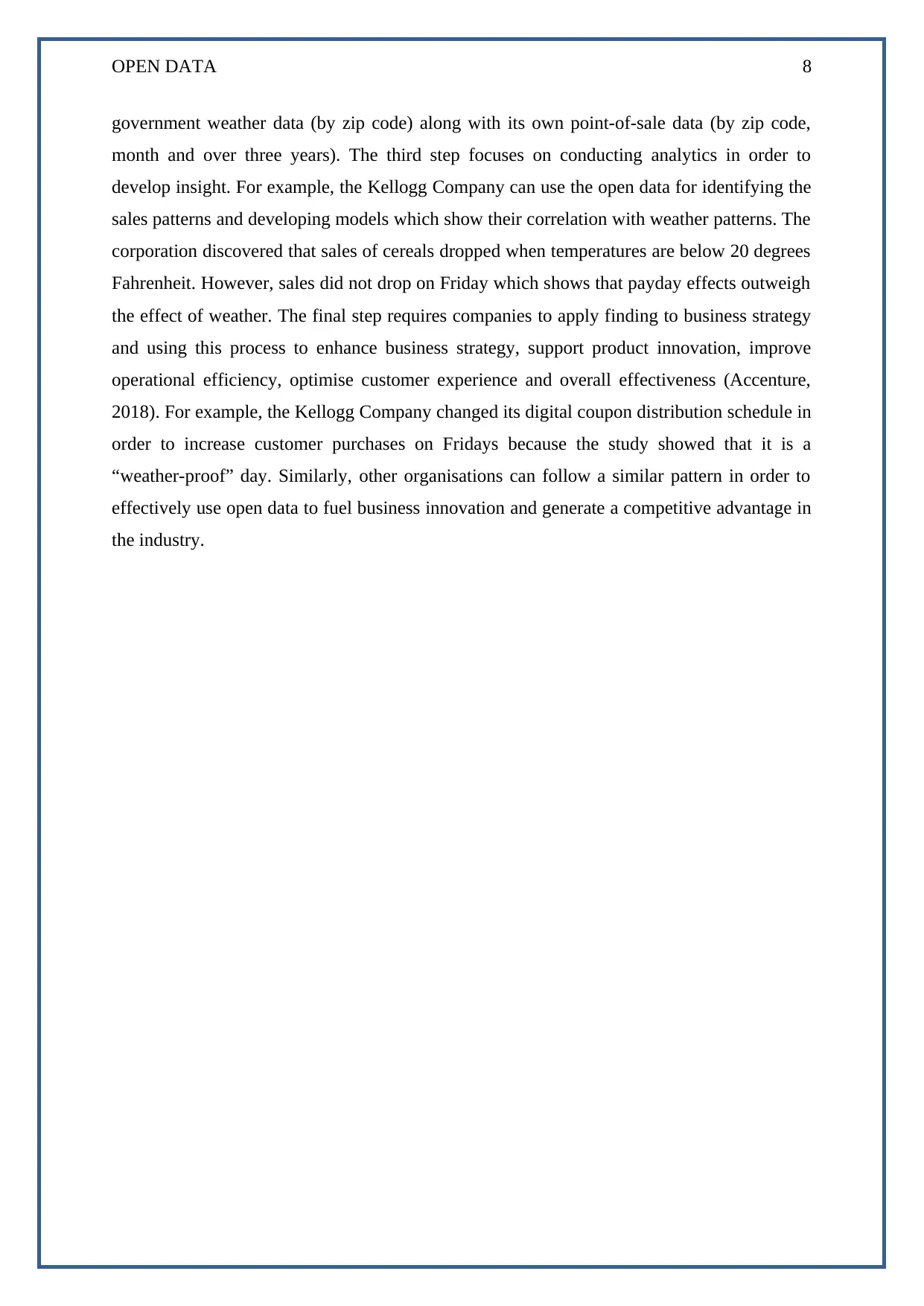
OPEN DATA 8
government weather data (by zip code) along with its own point-of-sale data (by zip code,
month and over three years). The third step focuses on conducting analytics in order to
develop insight. For example, the Kellogg Company can use the open data for identifying the
sales patterns and developing models which show their correlation with weather patterns. The
corporation discovered that sales of cereals dropped when temperatures are below 20 degrees
Fahrenheit. However, sales did not drop on Friday which shows that payday effects outweigh
the effect of weather. The final step requires companies to apply finding to business strategy
and using this process to enhance business strategy, support product innovation, improve
operational efficiency, optimise customer experience and overall effectiveness (Accenture,
2018). For example, the Kellogg Company changed its digital coupon distribution schedule in
order to increase customer purchases on Fridays because the study showed that it is a
“weather-proof” day. Similarly, other organisations can follow a similar pattern in order to
effectively use open data to fuel business innovation and generate a competitive advantage in
the industry.
government weather data (by zip code) along with its own point-of-sale data (by zip code,
month and over three years). The third step focuses on conducting analytics in order to
develop insight. For example, the Kellogg Company can use the open data for identifying the
sales patterns and developing models which show their correlation with weather patterns. The
corporation discovered that sales of cereals dropped when temperatures are below 20 degrees
Fahrenheit. However, sales did not drop on Friday which shows that payday effects outweigh
the effect of weather. The final step requires companies to apply finding to business strategy
and using this process to enhance business strategy, support product innovation, improve
operational efficiency, optimise customer experience and overall effectiveness (Accenture,
2018). For example, the Kellogg Company changed its digital coupon distribution schedule in
order to increase customer purchases on Fridays because the study showed that it is a
“weather-proof” day. Similarly, other organisations can follow a similar pattern in order to
effectively use open data to fuel business innovation and generate a competitive advantage in
the industry.
⊘ This is a preview!⊘
Do you want full access?
Subscribe today to unlock all pages.

Trusted by 1+ million students worldwide
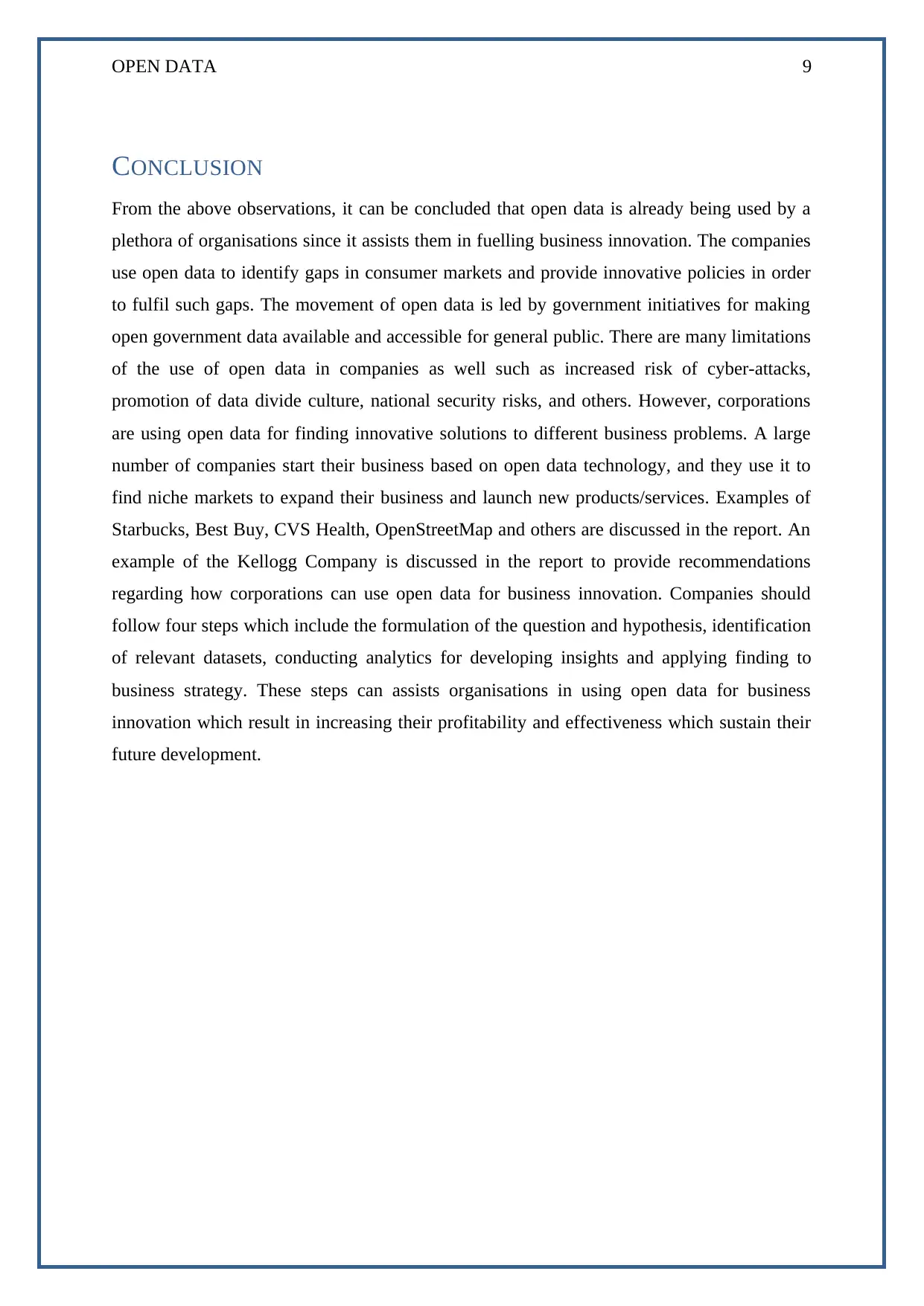
OPEN DATA 9
CONCLUSION
From the above observations, it can be concluded that open data is already being used by a
plethora of organisations since it assists them in fuelling business innovation. The companies
use open data to identify gaps in consumer markets and provide innovative policies in order
to fulfil such gaps. The movement of open data is led by government initiatives for making
open government data available and accessible for general public. There are many limitations
of the use of open data in companies as well such as increased risk of cyber-attacks,
promotion of data divide culture, national security risks, and others. However, corporations
are using open data for finding innovative solutions to different business problems. A large
number of companies start their business based on open data technology, and they use it to
find niche markets to expand their business and launch new products/services. Examples of
Starbucks, Best Buy, CVS Health, OpenStreetMap and others are discussed in the report. An
example of the Kellogg Company is discussed in the report to provide recommendations
regarding how corporations can use open data for business innovation. Companies should
follow four steps which include the formulation of the question and hypothesis, identification
of relevant datasets, conducting analytics for developing insights and applying finding to
business strategy. These steps can assists organisations in using open data for business
innovation which result in increasing their profitability and effectiveness which sustain their
future development.
CONCLUSION
From the above observations, it can be concluded that open data is already being used by a
plethora of organisations since it assists them in fuelling business innovation. The companies
use open data to identify gaps in consumer markets and provide innovative policies in order
to fulfil such gaps. The movement of open data is led by government initiatives for making
open government data available and accessible for general public. There are many limitations
of the use of open data in companies as well such as increased risk of cyber-attacks,
promotion of data divide culture, national security risks, and others. However, corporations
are using open data for finding innovative solutions to different business problems. A large
number of companies start their business based on open data technology, and they use it to
find niche markets to expand their business and launch new products/services. Examples of
Starbucks, Best Buy, CVS Health, OpenStreetMap and others are discussed in the report. An
example of the Kellogg Company is discussed in the report to provide recommendations
regarding how corporations can use open data for business innovation. Companies should
follow four steps which include the formulation of the question and hypothesis, identification
of relevant datasets, conducting analytics for developing insights and applying finding to
business strategy. These steps can assists organisations in using open data for business
innovation which result in increasing their profitability and effectiveness which sustain their
future development.
Paraphrase This Document
Need a fresh take? Get an instant paraphrase of this document with our AI Paraphraser
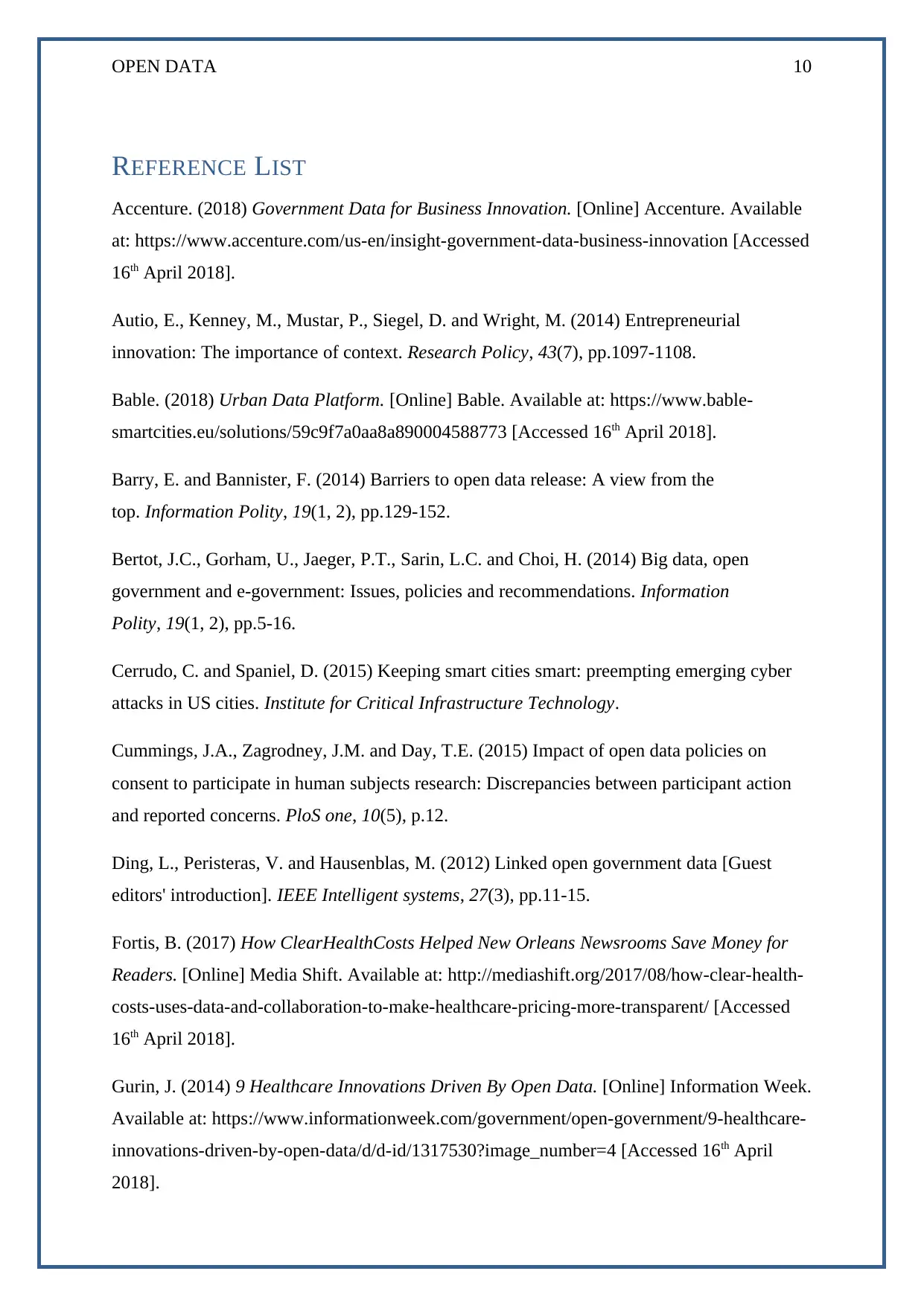
OPEN DATA 10
REFERENCE LIST
Accenture. (2018) Government Data for Business Innovation. [Online] Accenture. Available
at: https://www.accenture.com/us-en/insight-government-data-business-innovation [Accessed
16th April 2018].
Autio, E., Kenney, M., Mustar, P., Siegel, D. and Wright, M. (2014) Entrepreneurial
innovation: The importance of context. Research Policy, 43(7), pp.1097-1108.
Bable. (2018) Urban Data Platform. [Online] Bable. Available at: https://www.bable-
smartcities.eu/solutions/59c9f7a0aa8a890004588773 [Accessed 16th April 2018].
Barry, E. and Bannister, F. (2014) Barriers to open data release: A view from the
top. Information Polity, 19(1, 2), pp.129-152.
Bertot, J.C., Gorham, U., Jaeger, P.T., Sarin, L.C. and Choi, H. (2014) Big data, open
government and e-government: Issues, policies and recommendations. Information
Polity, 19(1, 2), pp.5-16.
Cerrudo, C. and Spaniel, D. (2015) Keeping smart cities smart: preempting emerging cyber
attacks in US cities. Institute for Critical Infrastructure Technology.
Cummings, J.A., Zagrodney, J.M. and Day, T.E. (2015) Impact of open data policies on
consent to participate in human subjects research: Discrepancies between participant action
and reported concerns. PloS one, 10(5), p.12.
Ding, L., Peristeras, V. and Hausenblas, M. (2012) Linked open government data [Guest
editors' introduction]. IEEE Intelligent systems, 27(3), pp.11-15.
Fortis, B. (2017) How ClearHealthCosts Helped New Orleans Newsrooms Save Money for
Readers. [Online] Media Shift. Available at: http://mediashift.org/2017/08/how-clear-health-
costs-uses-data-and-collaboration-to-make-healthcare-pricing-more-transparent/ [Accessed
16th April 2018].
Gurin, J. (2014) 9 Healthcare Innovations Driven By Open Data. [Online] Information Week.
Available at: https://www.informationweek.com/government/open-government/9-healthcare-
innovations-driven-by-open-data/d/d-id/1317530?image_number=4 [Accessed 16th April
2018].
REFERENCE LIST
Accenture. (2018) Government Data for Business Innovation. [Online] Accenture. Available
at: https://www.accenture.com/us-en/insight-government-data-business-innovation [Accessed
16th April 2018].
Autio, E., Kenney, M., Mustar, P., Siegel, D. and Wright, M. (2014) Entrepreneurial
innovation: The importance of context. Research Policy, 43(7), pp.1097-1108.
Bable. (2018) Urban Data Platform. [Online] Bable. Available at: https://www.bable-
smartcities.eu/solutions/59c9f7a0aa8a890004588773 [Accessed 16th April 2018].
Barry, E. and Bannister, F. (2014) Barriers to open data release: A view from the
top. Information Polity, 19(1, 2), pp.129-152.
Bertot, J.C., Gorham, U., Jaeger, P.T., Sarin, L.C. and Choi, H. (2014) Big data, open
government and e-government: Issues, policies and recommendations. Information
Polity, 19(1, 2), pp.5-16.
Cerrudo, C. and Spaniel, D. (2015) Keeping smart cities smart: preempting emerging cyber
attacks in US cities. Institute for Critical Infrastructure Technology.
Cummings, J.A., Zagrodney, J.M. and Day, T.E. (2015) Impact of open data policies on
consent to participate in human subjects research: Discrepancies between participant action
and reported concerns. PloS one, 10(5), p.12.
Ding, L., Peristeras, V. and Hausenblas, M. (2012) Linked open government data [Guest
editors' introduction]. IEEE Intelligent systems, 27(3), pp.11-15.
Fortis, B. (2017) How ClearHealthCosts Helped New Orleans Newsrooms Save Money for
Readers. [Online] Media Shift. Available at: http://mediashift.org/2017/08/how-clear-health-
costs-uses-data-and-collaboration-to-make-healthcare-pricing-more-transparent/ [Accessed
16th April 2018].
Gurin, J. (2014) 9 Healthcare Innovations Driven By Open Data. [Online] Information Week.
Available at: https://www.informationweek.com/government/open-government/9-healthcare-
innovations-driven-by-open-data/d/d-id/1317530?image_number=4 [Accessed 16th April
2018].
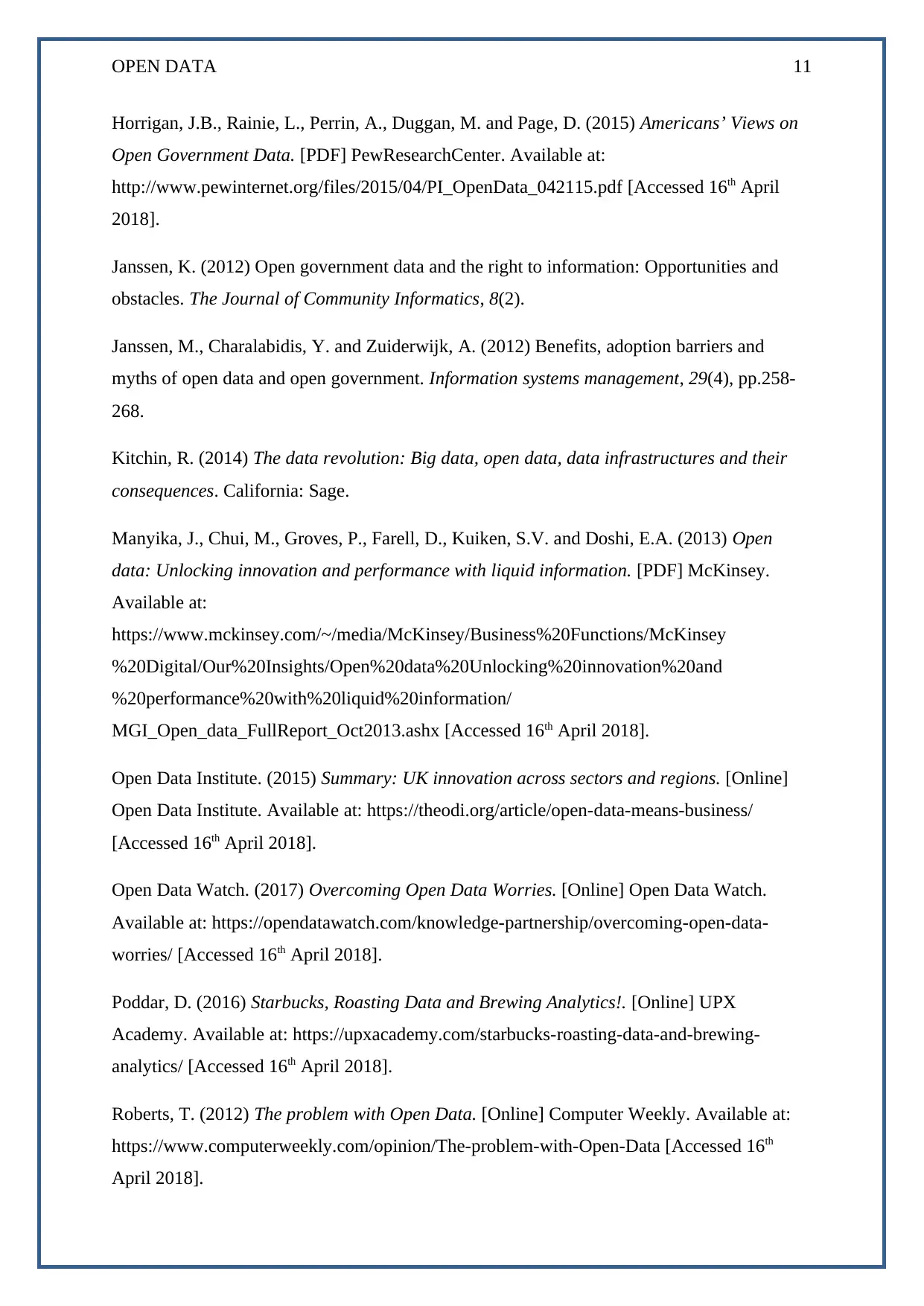
OPEN DATA 11
Horrigan, J.B., Rainie, L., Perrin, A., Duggan, M. and Page, D. (2015) Americans’ Views on
Open Government Data. [PDF] PewResearchCenter. Available at:
http://www.pewinternet.org/files/2015/04/PI_OpenData_042115.pdf [Accessed 16th April
2018].
Janssen, K. (2012) Open government data and the right to information: Opportunities and
obstacles. The Journal of Community Informatics, 8(2).
Janssen, M., Charalabidis, Y. and Zuiderwijk, A. (2012) Benefits, adoption barriers and
myths of open data and open government. Information systems management, 29(4), pp.258-
268.
Kitchin, R. (2014) The data revolution: Big data, open data, data infrastructures and their
consequences. California: Sage.
Manyika, J., Chui, M., Groves, P., Farell, D., Kuiken, S.V. and Doshi, E.A. (2013) Open
data: Unlocking innovation and performance with liquid information. [PDF] McKinsey.
Available at:
https://www.mckinsey.com/~/media/McKinsey/Business%20Functions/McKinsey
%20Digital/Our%20Insights/Open%20data%20Unlocking%20innovation%20and
%20performance%20with%20liquid%20information/
MGI_Open_data_FullReport_Oct2013.ashx [Accessed 16th April 2018].
Open Data Institute. (2015) Summary: UK innovation across sectors and regions. [Online]
Open Data Institute. Available at: https://theodi.org/article/open-data-means-business/
[Accessed 16th April 2018].
Open Data Watch. (2017) Overcoming Open Data Worries. [Online] Open Data Watch.
Available at: https://opendatawatch.com/knowledge-partnership/overcoming-open-data-
worries/ [Accessed 16th April 2018].
Poddar, D. (2016) Starbucks, Roasting Data and Brewing Analytics!. [Online] UPX
Academy. Available at: https://upxacademy.com/starbucks-roasting-data-and-brewing-
analytics/ [Accessed 16th April 2018].
Roberts, T. (2012) The problem with Open Data. [Online] Computer Weekly. Available at:
https://www.computerweekly.com/opinion/The-problem-with-Open-Data [Accessed 16th
April 2018].
Horrigan, J.B., Rainie, L., Perrin, A., Duggan, M. and Page, D. (2015) Americans’ Views on
Open Government Data. [PDF] PewResearchCenter. Available at:
http://www.pewinternet.org/files/2015/04/PI_OpenData_042115.pdf [Accessed 16th April
2018].
Janssen, K. (2012) Open government data and the right to information: Opportunities and
obstacles. The Journal of Community Informatics, 8(2).
Janssen, M., Charalabidis, Y. and Zuiderwijk, A. (2012) Benefits, adoption barriers and
myths of open data and open government. Information systems management, 29(4), pp.258-
268.
Kitchin, R. (2014) The data revolution: Big data, open data, data infrastructures and their
consequences. California: Sage.
Manyika, J., Chui, M., Groves, P., Farell, D., Kuiken, S.V. and Doshi, E.A. (2013) Open
data: Unlocking innovation and performance with liquid information. [PDF] McKinsey.
Available at:
https://www.mckinsey.com/~/media/McKinsey/Business%20Functions/McKinsey
%20Digital/Our%20Insights/Open%20data%20Unlocking%20innovation%20and
%20performance%20with%20liquid%20information/
MGI_Open_data_FullReport_Oct2013.ashx [Accessed 16th April 2018].
Open Data Institute. (2015) Summary: UK innovation across sectors and regions. [Online]
Open Data Institute. Available at: https://theodi.org/article/open-data-means-business/
[Accessed 16th April 2018].
Open Data Watch. (2017) Overcoming Open Data Worries. [Online] Open Data Watch.
Available at: https://opendatawatch.com/knowledge-partnership/overcoming-open-data-
worries/ [Accessed 16th April 2018].
Poddar, D. (2016) Starbucks, Roasting Data and Brewing Analytics!. [Online] UPX
Academy. Available at: https://upxacademy.com/starbucks-roasting-data-and-brewing-
analytics/ [Accessed 16th April 2018].
Roberts, T. (2012) The problem with Open Data. [Online] Computer Weekly. Available at:
https://www.computerweekly.com/opinion/The-problem-with-Open-Data [Accessed 16th
April 2018].
⊘ This is a preview!⊘
Do you want full access?
Subscribe today to unlock all pages.

Trusted by 1+ million students worldwide
1 out of 16
Related Documents
Your All-in-One AI-Powered Toolkit for Academic Success.
+13062052269
info@desklib.com
Available 24*7 on WhatsApp / Email
![[object Object]](/_next/static/media/star-bottom.7253800d.svg)
Unlock your academic potential
Copyright © 2020–2025 A2Z Services. All Rights Reserved. Developed and managed by ZUCOL.


